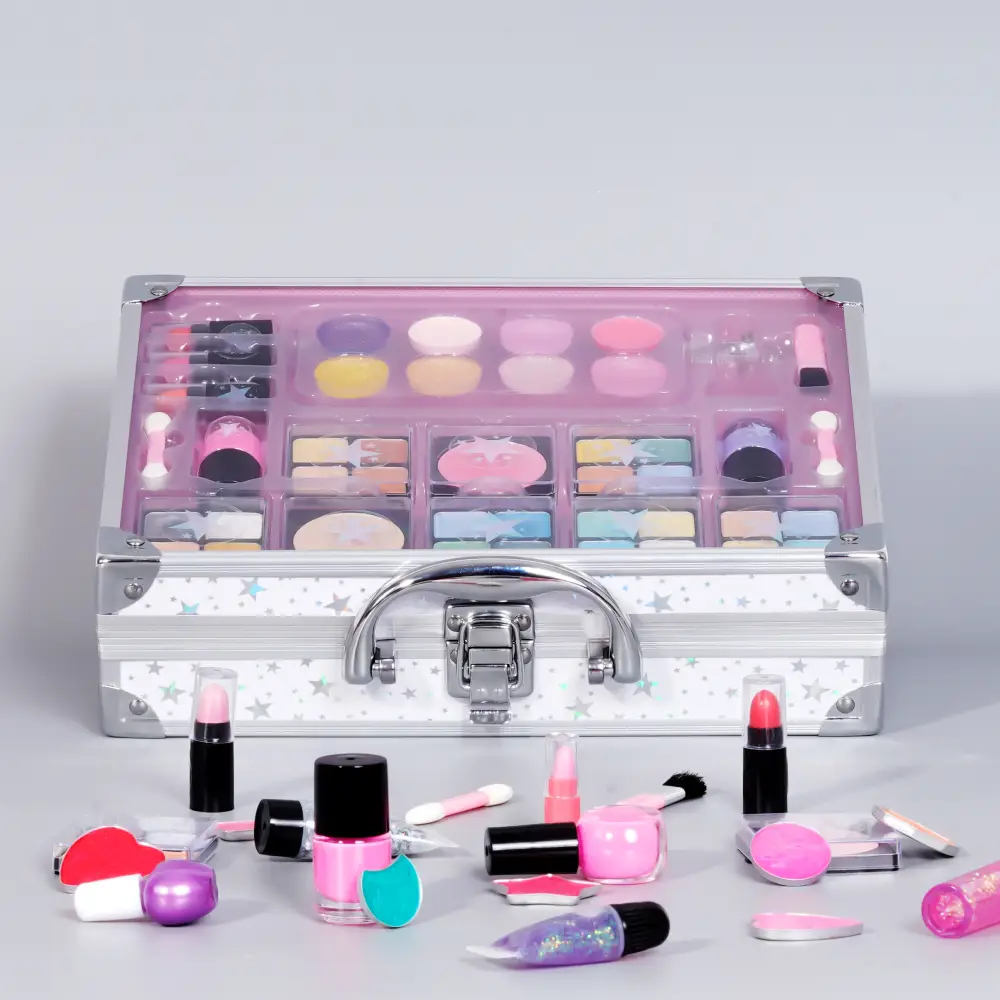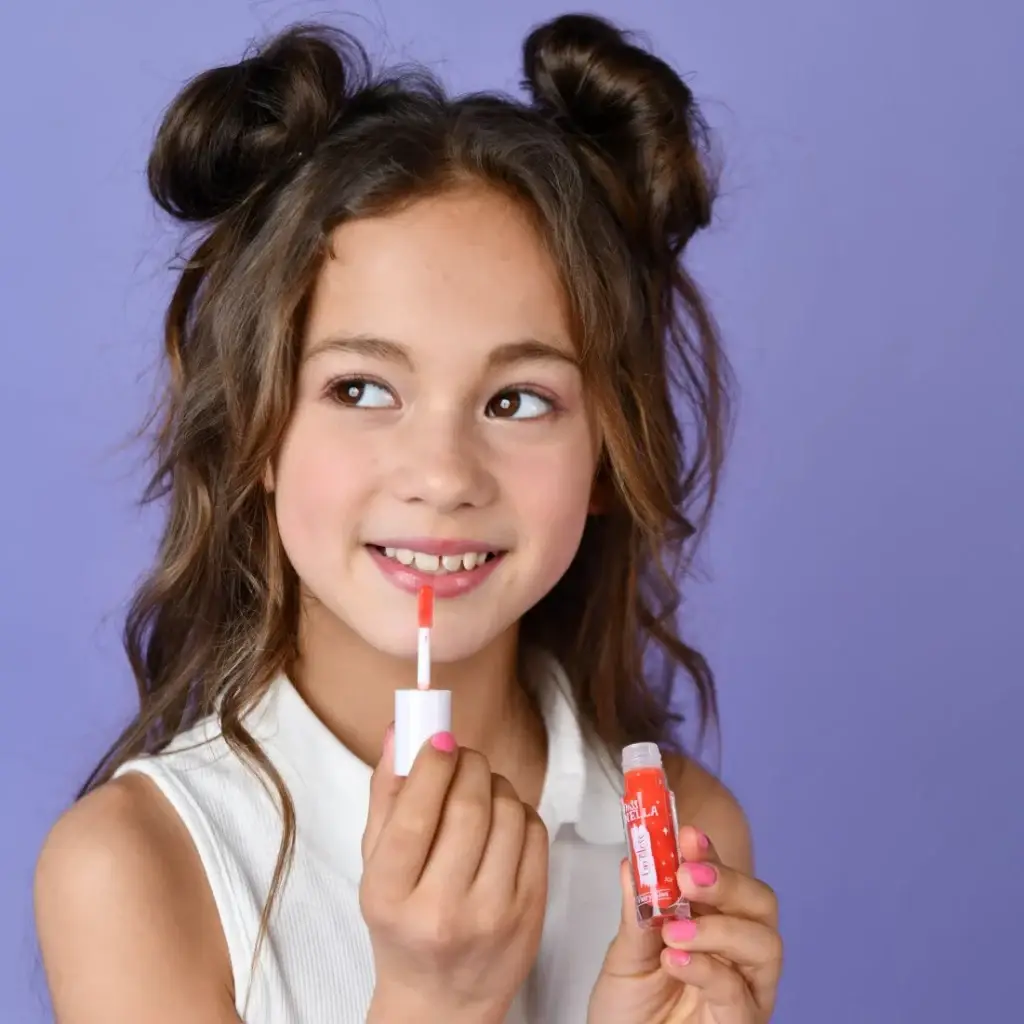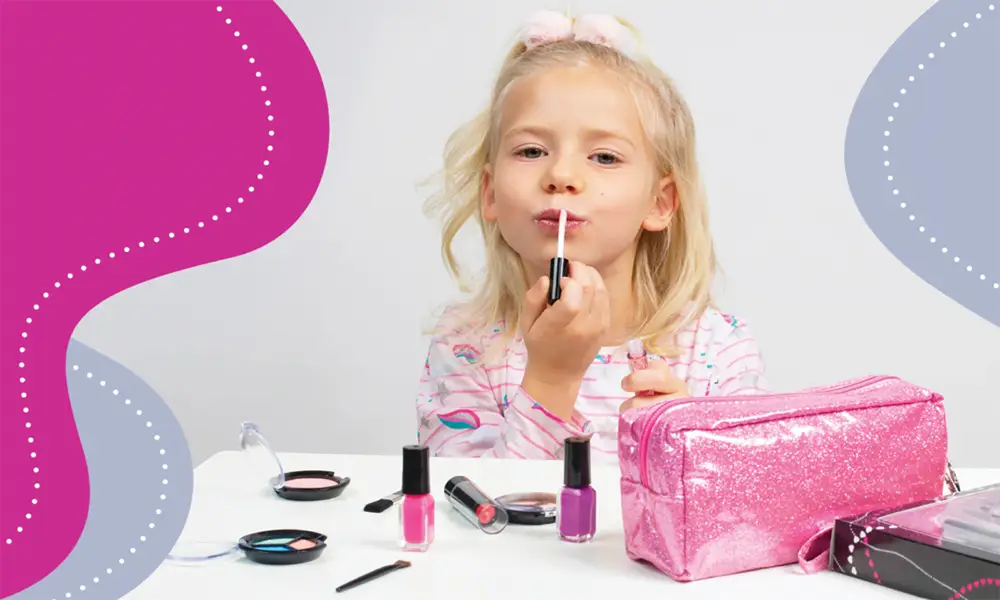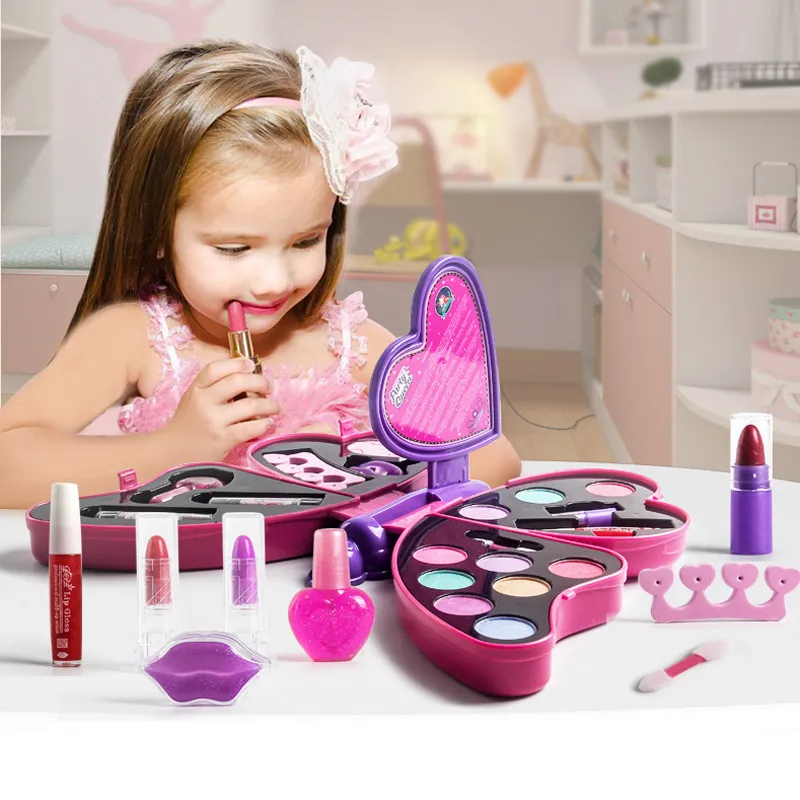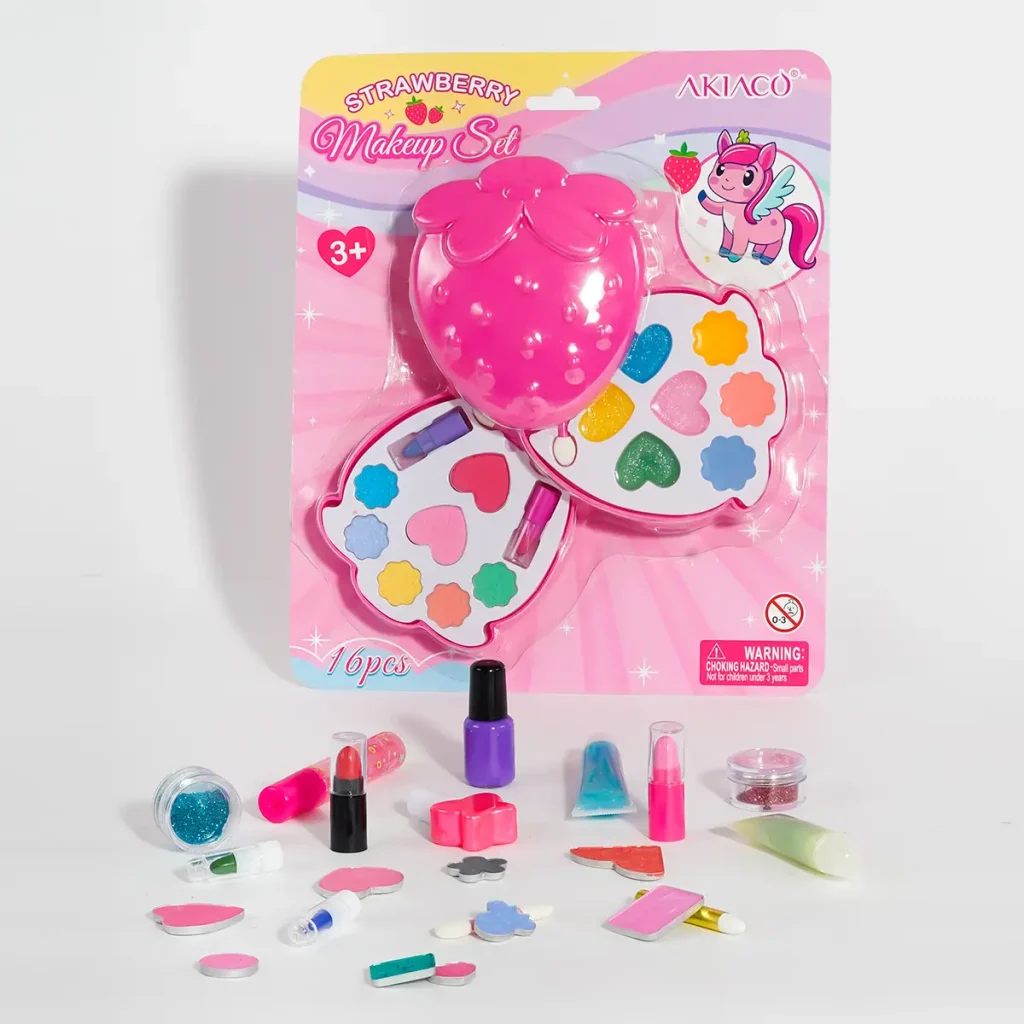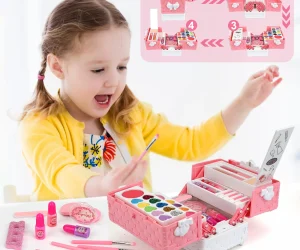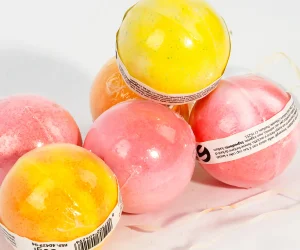Is It Safe for Kids to Wear Lipstick? A Caring Guide
Table of Contents
It is not unusual to see children reaching for a lipstick tube on a parent’s desk. Makeup feels like play to them, a way to copy adults or act out a story. Sometimes it happens during dress-up games, sometimes during family gatherings.
But as fun as this looks, the question quickly rises: is it safe for kids to wear lipstick? Parents often pause when they see their child’s lips painted red or pink. Behind the cute picture, there are real concerns about skin health and safety.
Understanding Why Kids Want to Wear Lipstick
Kids reaching for lipstick is not always about beauty. It often comes from curiosity, play, and the wish to copy people they trust. Lipstick becomes more than color; it is a tool for pretend stories and identity exploration.
The role of curiosity and play in child development
Children are natural explorers. They test the world by touching, tasting, and trying things that belong to adults. A lipstick tube is bright, smooth, and easy to notice. To a child, it looks like a new toy waiting to be explored.
Play is also how kids learn about social roles. Just as they pretend to cook or drive cars, putting on lipstick becomes part of acting out “being grown-up.” This does not mean they are chasing beauty standards; often, it is simply role-play.
For example, a five-year-old might smear lipstick before pretending to be a teacher. The color itself is not the point—it is the act of stepping into a role. Psychologists note that such play supports imagination and emotional growth.
Influence of media, peers, and family
Children also copy what they see. Media shows characters with shiny lips, and peers may bring toy makeup to playdates. If others are doing it, kids may want to join in. This is part of normal social learning.
Family plays a strong role too. When a child sees a parent applying lipstick before leaving the house, they connect the act with confidence and care. Trying it themselves is their way of imitating love and daily habits.
At times, older siblings or cousins share makeup during games. These moments can make lipstick feel like a shared secret or a “big kid” ritual. It is less about style and more about belonging to the group.
Is It Safe for Kids to Wear Lipstick? The Science Explained
The safety of lipstick for children is a common worry for parents. Unlike toys, makeup is made for adult skin. Kids have thinner, more delicate skin, which may react differently. Science helps us sort facts from fear.
What experts say about child skin sensitivity
Dermatologists often point out that a child’s skin barrier is still developing. It is thinner, loses water faster, and absorbs more substances compared to adult skin. This makes children more likely to react to dyes, fragrances, or preservatives found in lipsticks.
The lips themselves are more exposed. Unlike the rest of the skin, lips have no oil glands to protect them. If a lipstick contains allergens or harsh chemicals, a child may feel irritation, dryness, or redness more quickly. Pediatricians recommend patch testing before any use.
Case studies show that even “mild” reactions like chapped lips or rashes can become recurring if exposure continues. While most are not dangerous, repeated irritation can lead to discomfort and, in rare cases, allergic contact dermatitis.
Short-term vs. long-term considerations
Short-term effects often include temporary staining, mild irritation, or accidental swallowing. Many kids lick their lips, which means small amounts of lipstick may end up in the stomach. Most modern lipsticks are considered non-toxic in these amounts, but ingestion is not encouraged.
Long-term exposure is harder to study. Some research has raised questions about trace metals like lead in lipstick. While levels in regulated markets are very low (U.S. FDA, 2012), children are more vulnerable because of their smaller body size. Even minimal buildup may be more significant over time.
Experts agree: occasional supervised use for play is unlikely to cause harm. But daily or unsupervised use increases risks, especially if the product is not designed for kids. Moderation and awareness make the biggest difference.
Common Ingredients Found in Lipstick
Lipstick is made of many small parts that work together—waxes for shape, oils for smoothness, and pigments for color. Some are natural, while others are synthetic. Understanding these helps parents know what touches a child’s skin.
Natural waxes, oils, and pigments
Most lipsticks use waxes like beeswax or carnauba to give structure. These create a solid stick that won’t melt too fast in the hand. Oils such as castor, jojoba, or mineral oil are added to keep lips soft and give the product glide.
Pigments bring color, and many are safe minerals like iron oxides. Some newer brands even use food-grade dyes. While these ingredients are generally safe, kids’ lips may still react if they are sensitive or prone to dryness.
Parents sometimes assume “natural” means risk-free, but that’s not always true. Even natural oils or plant extracts can trigger allergies. A child with eczema, for instance, might react more strongly to certain botanical oils than to a synthetic base.
Preservatives, fragrances, and synthetic colorants
Because lipstick sits in warm places like pockets or bags, preservatives are needed to stop mold and bacteria. Common ones include parabens or phenoxyethanol. While safe for adults at low levels, they may irritate children with delicate skin.
Fragrances are another concern. They are often hidden under the single word “fragrance” on labels, but they may include many different chemicals. Kids are more prone to irritation from scented products, especially on thin lip skin.
Synthetic colorants, such as FD&C dyes, make lipsticks bright and bold. Regulations limit their levels, but parents may still prefer to avoid them for young kids. Some studies have debated links to sensitivity, though evidence is mixed.
Potential Risks of Kids Wearing Lipstick
While lipstick is designed for safe adult use, children are not small adults. Their skin, habits, and biology make certain risks higher. Knowing these helps parents make thoughtful choices.
Skin reactions and allergies
Children’s skin is thinner and less developed than adults’, which makes it more reactive. Ingredients like fragrances, dyes, or even natural oils can cause redness, itching, or small rashes.
A simple story: one parent noticed her child’s lips became red after play makeup. It wasn’t serious, but it showed how even mild products can trigger reactions in sensitive kids. Patch tests are one way to check before full use.
Accidental ingestion of lipstick
Kids often lick their lips or put objects in their mouths. That means a layer of lipstick may not stay on the skin but end up swallowed. Small amounts are usually harmless, but frequent ingestion can lead to stomach upset.
Health groups like the American Academy of Pediatrics note that young children are more likely to swallow cosmetics compared to older kids. This does not always cause harm, but it adds a layer of concern for parents to consider.
Concerns about heavy metals in pigments
Studies have shown that some lipsticks contain trace metals like lead, cadmium, or aluminum. These are often present at very low levels, but kids are more vulnerable to exposure than adults.
The FDA has stated that trace lead in lipstick is not a safety risk for adults. Yet, when it comes to children, experts often recommend avoiding daily use, since their bodies absorb metals more easily. This is especially true with frequent play.
Age Considerations for Kids Wearing Lipstick
Not all ages carry the same level of risk when it comes to makeup. A toddler’s habits differ greatly from a school-aged child’s. Age plays a key role in safety and supervision.
Toddlers vs. school-age children
Toddlers explore the world by touching and tasting. Lipstick at this stage is often smeared on skin, furniture, or eaten. Their thin skin and frequent hand-to-mouth behavior make lipstick less safe.
School-age children, on the other hand, may use lipstick during playdates or parties. They understand instructions better and can avoid swallowing as much. Still, their skin can react quickly, so occasional use with mild products is safest.
When is supervised use acceptable?
Supervised use becomes reasonable when children can follow simple hygiene rules. For example, a parent might allow lipstick during a school play, family party, or photo shoot.
The key is balance: short periods, careful removal afterward, and choosing products free of harsh chemicals. Parents staying close helps avoid habits like licking or rubbing, which increase risks.
Safer Alternatives to Regular Lipstick for Kids
When kids ask to try makeup, parents often look for safe options. Instead of regular lipstick, lighter and child-friendly choices can give color without as many risks.
Tinted balms and clear gloss
Tinted balms give a soft color while also keeping lips smooth. They are usually made with simple waxes and oils, which lowers the chance of irritation. Because they are sheer, children are less likely to pile on thick layers.
Clear gloss is another easy choice. It adds shine without strong pigments. Kids can enjoy the “grown-up” feeling of makeup, but parents worry less about harmful ingredients or stains on skin.
Non-toxic play makeup designed for children
Play makeup kits for children are specially tested for safety. Many are free from harsh dyes, parabens, and heavy metals. They wash off with water, which reduces the chance of long exposure.
These sets also turn makeup into play rather than serious cosmetic use. A child may share the kit with friends or use it in pretend games. This helps them explore safely, while parents can step in if needed.
Hygiene and Application Tips for Kids Wearing Lipstick
Even if the lipstick itself is safe, the way it is used matters. Good hygiene helps lower risks of skin problems or germs spreading when children experiment with makeup.
Importance of clean hands and sanitized products
Kids often touch their face before applying lipstick. Dirty hands can move bacteria or dirt onto the lips, which may lead to irritation. Teaching children to wash hands first makes the process safer.
Lipsticks and balms can also collect dust or germs if left uncapped. Parents can remind kids to close products tightly and wipe them clean. A simple routine can keep the makeup fresh longer.
Why kids should not share lip products
It may seem fun to swap lipsticks with friends, but sharing can spread germs. Viruses like cold sores or simple skin infections often move through shared items.
Explaining this to children in a clear way—“your lips are like your toothbrush, only for you”—helps them understand. Keeping each child’s products separate is an easy step to avoid problems.
Cultural and Social Perspectives on Kids Wearing Lipstick
Children wearing makeup is viewed differently around the world. Understanding these perspectives helps parents balance fun, self-expression, and safety.
How different cultures view makeup in childhood
In some cultures, makeup is part of traditional celebrations. For example, during festivals or performances, children may wear lipstick and other cosmetics as part of costume rituals. Here, lipstick is not about beauty standards but cultural expression.
Other societies prefer minimal or no makeup for young children. Early cosmetic use may be discouraged due to concerns about health, modesty, or age-appropriate behavior. Parents navigating these norms must weigh local expectations against personal values.
Balancing self-expression with safety
Makeup can support creativity, role-play, and confidence. Children often enjoy experimenting with colors and textures, which helps them explore identity safely.
Parents can guide this play by choosing safe products, limiting use, and supervising application. This approach allows self-expression while avoiding potential risks, such as irritation or accidental ingestion.
Guidance for Parents on Talking About Makeup
Parents play a key role in helping children explore makeup safely. Clear communication and gentle guidance encourage curiosity while protecting health and well-being.
Encouraging creativity without pressure
Makeup can be a form of imaginative play, similar to dressing up or painting. Parents can allow children to experiment with safe products, emphasizing fun rather than appearance.
For instance, letting a child apply a tinted balm during a pretend play session gives them freedom to explore colors. Praise their creativity, not the final look, so children don’t feel pressure to “look perfect.”
Teaching boundaries and self-care habits
It’s important to teach kids limits, such as not sharing products and washing them off after play. These habits prevent infections and reduce exposure to ingredients that might irritate sensitive skin.
Parents can also show children how to remove makeup gently, store products properly, and recognize reactions like redness or itching. Early lessons in self-care help children enjoy makeup safely and responsibly.
Conclusion
Children exploring makeup can be safe when guided carefully. Choosing gentle products, supervising use, and teaching hygiene lets kids enjoy creativity while minimizing risks and protecting their delicate skin.
FAQ
Daily use is not recommended for young children. Even mild products can irritate sensitive lips over time. Limiting use to occasional play or special events reduces risks and supports healthy skin.
Not always. Natural or organic ingredients can still trigger allergies, especially in children with sensitive skin. Parents should check labels carefully and perform a patch test before use.
A simple patch test can help. Apply a small amount to the inner arm or lip for a few hours. Watch for redness, itching, or swelling. If no reaction occurs, supervised use is usually safe.
Yes, toy or play lipsticks made for children are designed to be non-toxic and washable. They allow safe role-play without exposing kids to adult cosmetic chemicals or heavy pigments.
Store in a cool, dry place, tightly capped, and out of reach of very young children. This prevents contamination, melting, or accidental ingestion while maintaining product safety and hygiene.


